tow bar MINI Clubman 2011 Owner's Manual (Mini Connected)
[x] Cancel search | Manufacturer: MINI, Model Year: 2011, Model line: Clubman, Model: MINI Clubman 2011Pages: 256, PDF Size: 3.75 MB
Page 33 of 256
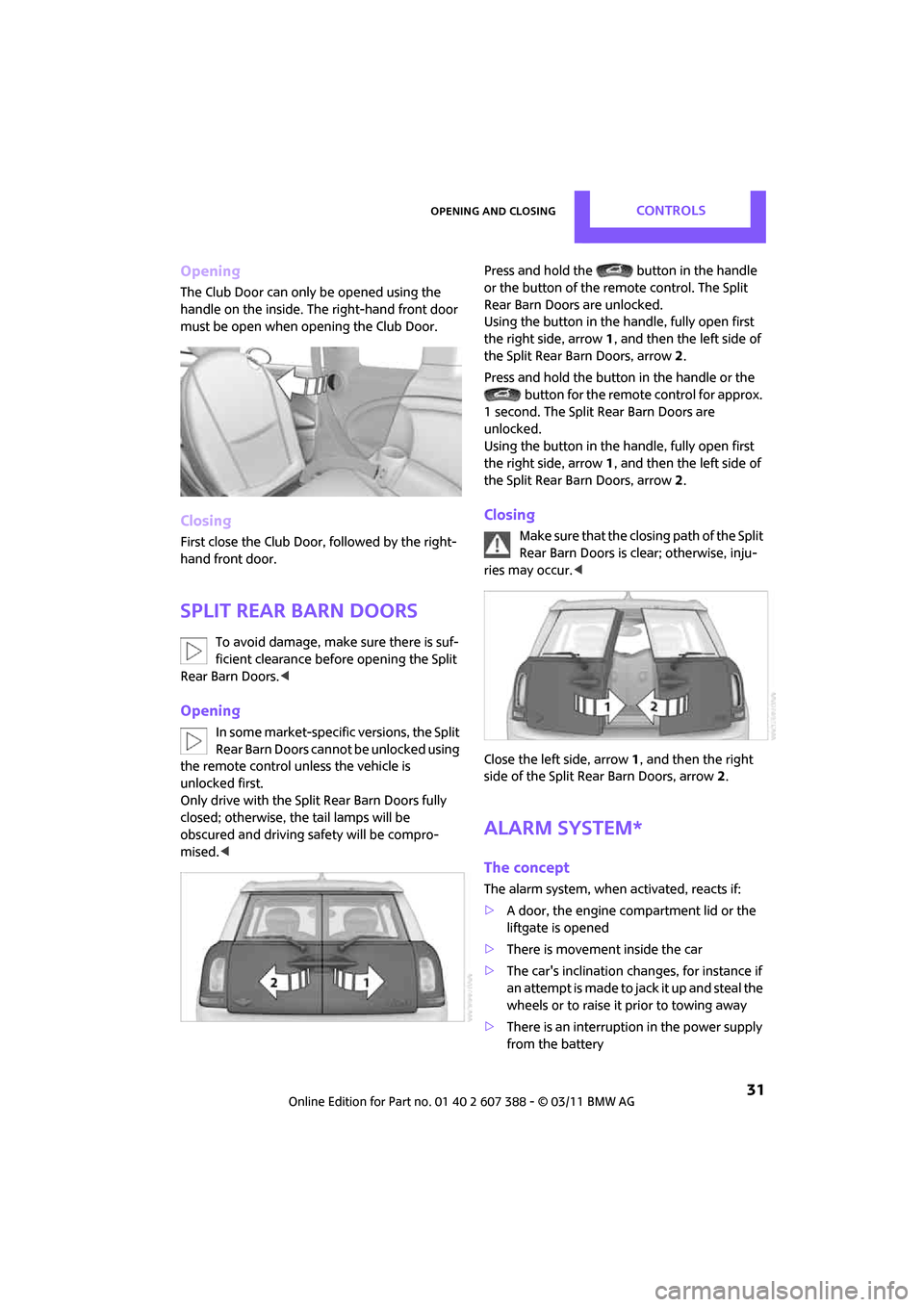
Opening and closingCONTROLS
31
Opening
The Club Door can only be opened using the
handle on the inside. The right-hand front door
must be open when opening the Club Door.
Closing
First close the Club Door, followed by the right-
hand front door.
Split Rear Barn Doors
To avoid damage, make sure there is suf-
ficient clearance before opening the Split
Rear Barn Doors. <
Opening
In some market-specific versions, the Split
Rear Barn Doors cannot be unlocked using
the remote control unless the vehicle is
unlocked first.
Only drive with the Split Rear Barn Doors fully
closed; otherwise, the tail lamps will be
obscured and driving safety will be compro-
mised. < Press and hold the button in the handle
or the button of the remote control. The Split
Rear Barn Doors are unlocked.
Using the button in the handle, fully open first
the right side, arrow
1, and then the left side of
the Split Rear Barn Doors, arrow 2.
Press and hold the button in the handle or the button for the remote control for approx.
1 second. The Split Rear Barn Doors are
unlocked.
Using the button in the handle, fully open first
the right side, arrow 1, and then the left side of
the Split Rear Barn Doors, arrow 2.
Closing
Make sure that the closing path of the Split
Rear Barn Doors is clear; otherwise, inju-
ries may occur. <
Close the left side, arrow 1, and then the right
side of the Split Rear Barn Doors, arrow 2.
Alarm system*
The concept
The alarm system, when activated, reacts if:
> A door, the engine compartment lid or the
liftgate is opened
> There is movement inside the car
> The car's inclination changes, for instance if
an attempt is made to jack it up and steal the
wheels or to raise it prior to towing away
> There is an interruption in the power supply
from the battery
Page 70 of 256
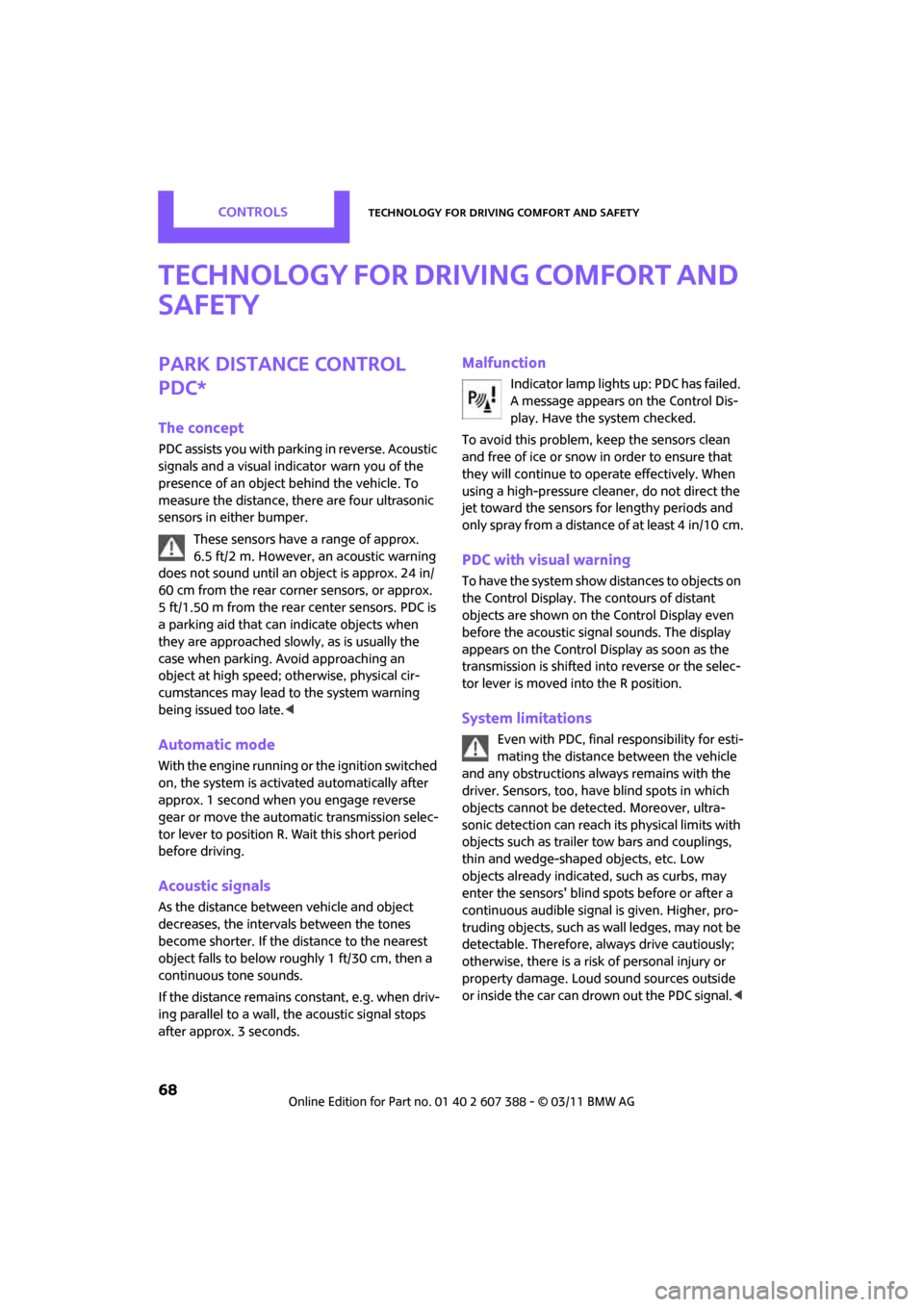
CONTROLSTechnology for driving comfort and safety
68
Technology for driving comfort and
safety
Park Distance Control
PDC*
The concept
PDC assists you with parking in reverse. Acoustic
signals and a visual indicator
warn you of the
presence of an object behind the vehicle. To
measure the distance, there are four ultrasonic
sensors in either bumper.
These sensors have a range of approx.
6.5 ft/2 m. However, an acoustic warning
does not sound until an object is approx. 24 in/
60 cm from the rear corner sensors, or approx.
5 ft/1.50 m from the rear center sensors. PDC is
a parking aid that can indicate objects when
they are approached slowly, as is usually the
case when parking. Avoid approaching an
object at high speed; ot herwise, physical cir-
cumstances may lead to the system warning
being issued too late. <
Automatic mode
With the engine running or the ignition switched
on, the system is activated automatically after
approx. 1 second when you engage reverse
gear or move the automatic transmission selec-
tor lever to position R. Wait this short period
before driving.
Acoustic signals
As the distance between vehicle and object
decreases, the intervals between the tones
become shorter. If the distance to the nearest
object falls to below roughly 1 ft/30 cm, then a
continuous tone sounds.
If the distance remains co nstant, e.g. when driv-
ing parallel to a wall, th e acoustic signal stops
after approx. 3 seconds.
Malfunction
Indicator lamp lights up: PDC has failed.
A message appears on the Control Dis-
play. Have the system checked.
To avoid this problem, keep the sensors clean
and free of ice or snow in order to ensure that
they will continue to operate effectively. When
using a high-pressure cleaner, do not direct the
jet toward the sensors for lengthy periods and
only spray from a distance of at least 4 in/10 cm.
PDC with visual warning
To have the system show distances to objects on
the Control Display. The contours of distant
objects are shown on the Control Display even
before the acoustic sign al sounds. The display
appears on the Control Display as soon as the
transmission is shifted into reverse or the selec-
tor lever is moved into the R position.
System limitations
Even with PDC, final responsibility for esti-
mating the distance between the vehicle
and any obstructions always remains with the
driver. Sensors, too, have blind spots in which
objects cannot be dete cted. Moreover, ultra-
sonic detection can reach its physical limits with
objects such as trailer tow bars and couplings,
thin and wedge-shaped objects, etc. Low
objects already indicated, such as curbs, may
enter the sensors' blind spots before or after a
continuous audible signal is given. Higher, pro-
truding objects, such as wall ledges, may not be
detectable. Therefore, always drive cautiously;
otherwise, there is a risk of personal injury or
property damage. Loud sound sources outside
or inside the car can drown out the PDC signal. <
Page 211 of 256
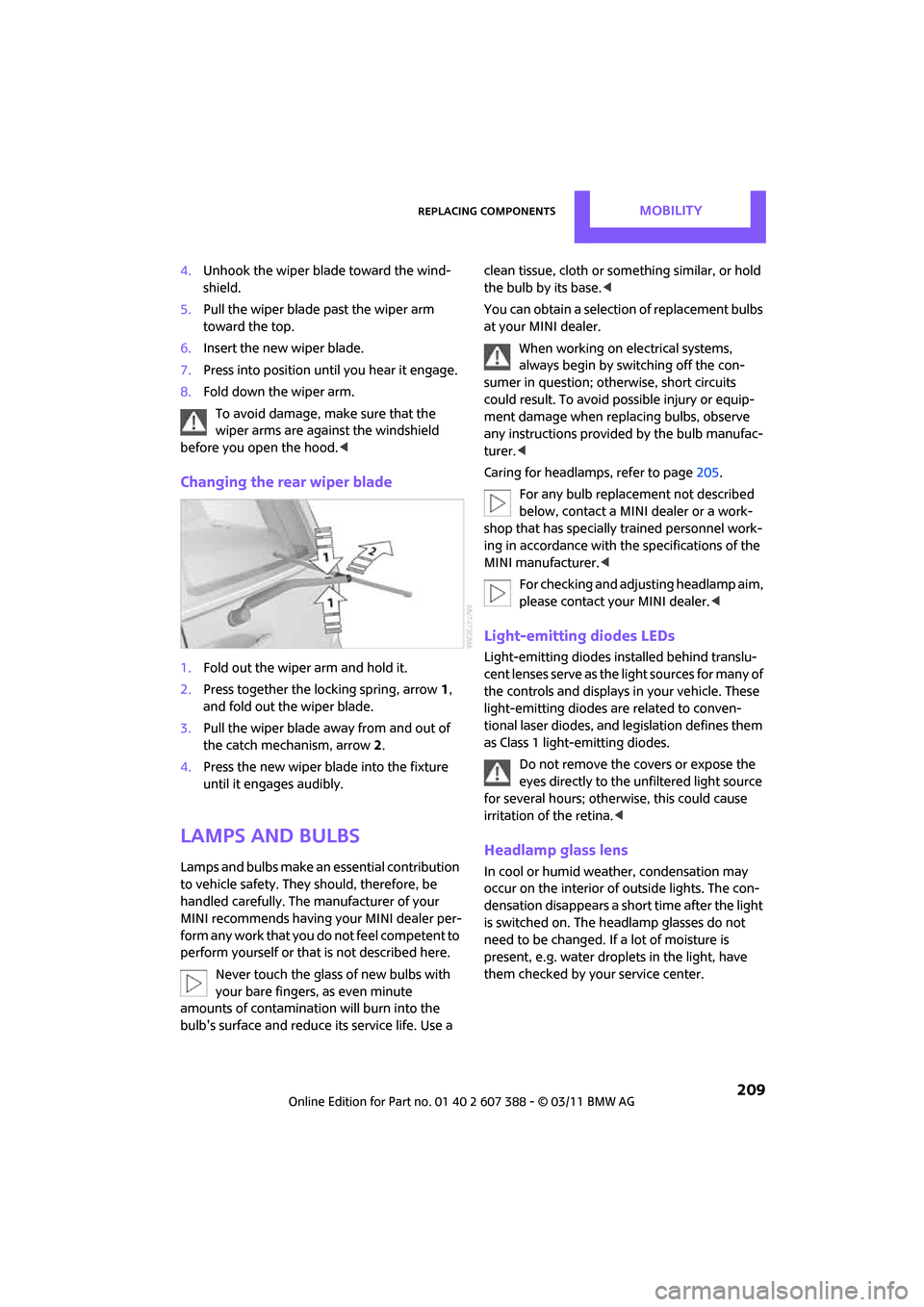
Replacing componentsMOBILITY
209
4.Unhook the wiper blade toward the wind-
shield.
5. Pull the wiper blade past the wiper arm
toward the top.
6. Insert the new wiper blade.
7. Press into position until you hear it engage.
8. Fold down the wiper arm.
To avoid damage, make sure that the
wiper arms are against the windshield
before you open the hood. <
Changing the rear wiper blade
1.Fold out the wiper arm and hold it.
2. Press together the locking spring, arrow 1,
and fold out the wiper blade.
3. Pull the wiper blade away from and out of
the catch mechanism, arrow 2.
4. Press the new wiper blade into the fixture
until it engages audibly.
Lamps and bulbs
Lamps and bulbs make an essential contribution
to vehicle safety. They should, therefore, be
handled carefully. The manufacturer of your
MINI recommends having your MINI dealer per-
form any work that you do not feel competent to
perform yourself or that is not described here.
Never touch the glass of new bulbs with
your bare fingers, as even minute
amounts of contaminatio n will burn into the
bulb's surface and reduce its service life. Use a clean tissue, cloth or some
thing similar, or hold
the bulb by its base.<
You can obtain a selectio n of replacement bulbs
at your MINI dealer.
When working on electrical systems,
always begin by switching off the con-
sumer in question; otherwise, short circuits
could result. To avoid possible injury or equip-
ment damage when replacing bulbs, observe
any instructions provided by the bulb manufac-
turer. <
Caring for headlamps, refer to page 205.
For any bulb replacement not described
below, contact a MINI dealer or a work-
shop that has specially trained personnel work-
ing in accordance with th e specifications of the
MINI manufacturer. <
For checking and adjusting headlamp aim,
please contact your MINI dealer. <
Light-emitting diodes LEDs
Light-emitting diodes installed behind translu-
cent lenses serve as the light sources for many of
the controls and displays in your vehicle. These
light-emitting diodes are related to conven-
tional laser diodes, and legislation defines them
as Class 1 light-emitting diodes.
Do not remove the covers or expose the
eyes directly to the unfiltered light source
for several hours; otherwise, this could cause
irritation of the retina. <
Headlamp glass lens
In cool or humid weather, condensation may
occur on the interior of outside lights. The con-
densation disappears a short time after the light
is switched on. The headlamp glasses do not
need to be changed. If a lot of moisture is
present, e.g. water droplets in the light, have
them checked by your service center.
Page 223 of 256
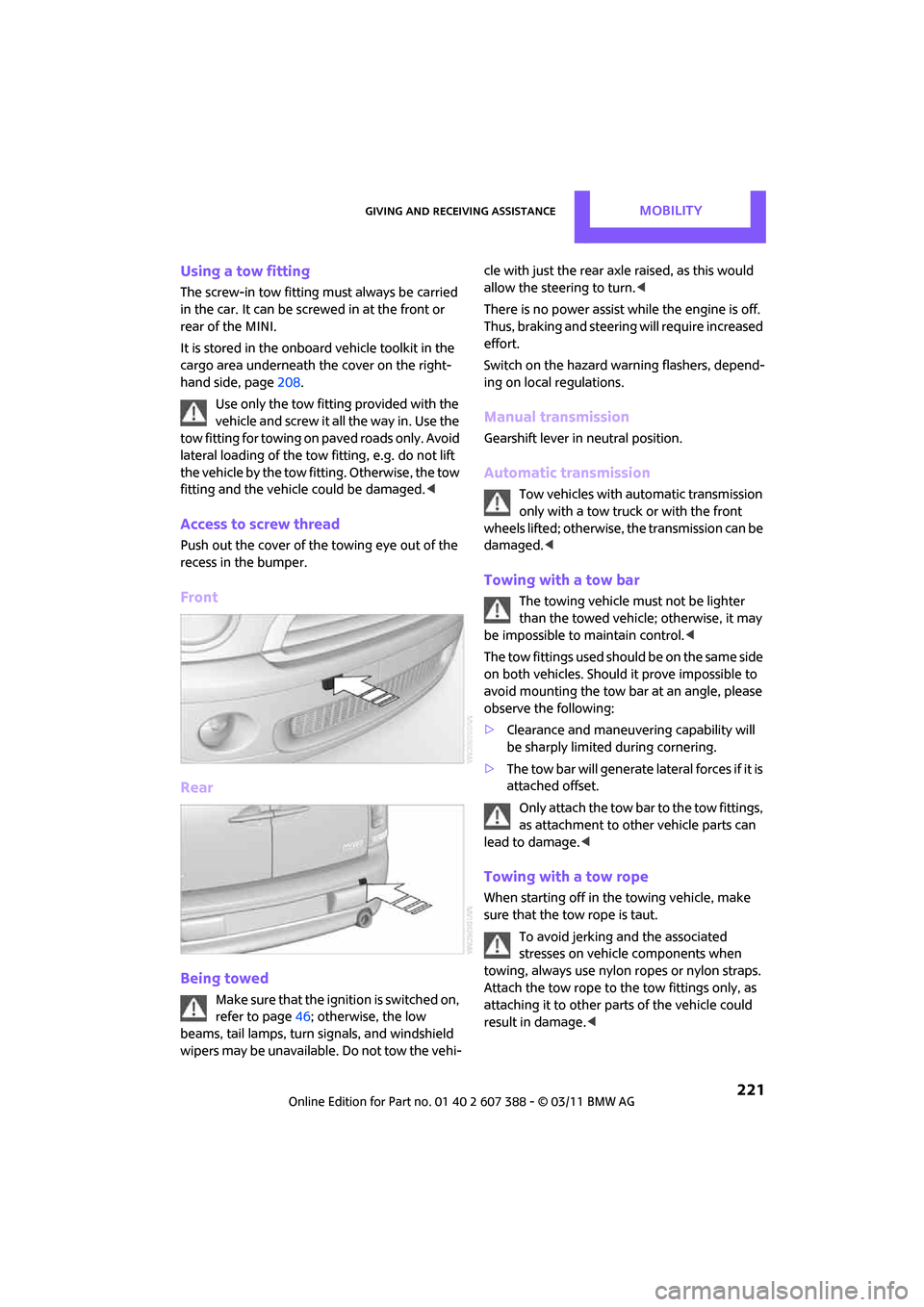
Giving and receiving assistanceMOBILITY
221
Using a tow fitting
The screw-in tow fitting must always be carried
in the car. It can be screwed in at the front or
rear of the MINI.
It is stored in the onboard vehicle toolkit in the
cargo area underneath the cover on the right-
hand side, page 208.
Use only the tow fitting provided with the
vehicle and screw it all the way in. Use the
tow fitting for towing on paved roads only. Avoid
lateral loading of the tow fitting, e.g. do not lift
the vehicle by the tow fitting. Otherwise, the tow
fitting and the vehicle could be damaged. <
Access to screw thread
Push out the cover of the towing eye out of the
recess in the bumper.
Front
Rear
Being towed
M a k e s u r e t h a t t h e i g n i t i o n i s s w i t c h e d o n ,
refer to page46; otherwise, the low
beams, tail lamps, turn signals, and windshield
wipers may be unavailable. Do not tow the vehi- cle with just the rear ax
le raised, as this would
allow the steering to turn. <
There is no power assist while the engine is off.
Thus, braking and steering will require increased
effort.
Switch on the hazard warning flashers, depend-
ing on local regulations.
Manual transmission
Gearshift lever in neutral position.
Automatic transmission
Tow vehicles with automatic transmission
only with a tow truck or with the front
wheels lifted; otherwise, the transmission can be
damaged. <
Towing with a tow bar
The towing vehicle must not be lighter
than the towed vehicle; otherwise, it may
be impossible to maintain control. <
The tow fittings used should be on the same side
on both vehicles. Should it prove impossible to
avoid mounting the tow bar at an angle, please
observe the following:
> Clearance and maneuvering capability will
be sharply limited during cornering.
> The tow bar will generate lateral forces if it is
attached offset.
Only attach the tow bar to the tow fittings,
as attachment to ot her vehicle parts can
lead to damage. <
Towing with a tow rope
When starting off in the towing vehicle, make
sure that the tow rope is taut.
To avoid jerking and the associated
stresses on vehicle components when
towing, always use nylon ropes or nylon straps.
Attach the tow rope to the tow fittings only, as
attaching it to other parts of the vehicle could
result in damage. <
Page 224 of 256

MOBILITYGiving and receiving assistance
222
Towing with a tow truck
Have the MINI Clubman transported with a tow
truck with a so-called lift bar or on a flat bed.Do not lift the vehicle by a tow fitting or
body and chassis parts; otherwise, dam-
age may result. <
Tow-starting
Avoid tow-starting the vehicle whenever possi-
ble; instead, jump-start the engine, page 219.
Vehicles with a catalyti c converter should only
be tow-started when the engine is cold, vehicles
with an automatic transmission cannot be tow-
started at all.
1. Switch on hazard warning flashers, comply
with local regulations.
2. Switch on the ignition, page 46.
3. Shift into 3rd gear.
4. Have the vehicle tow-started with the clutch
completely depressed and then slowly
release the clutch. Afte r the engine starts,
immediately depress the clutch completely
again.
5. Stop at a suitable lo cation, remove the tow
bar or rope and switch off the hazard warn-
ing flashers.
6. Have the vehicle checked.
Page 241 of 256
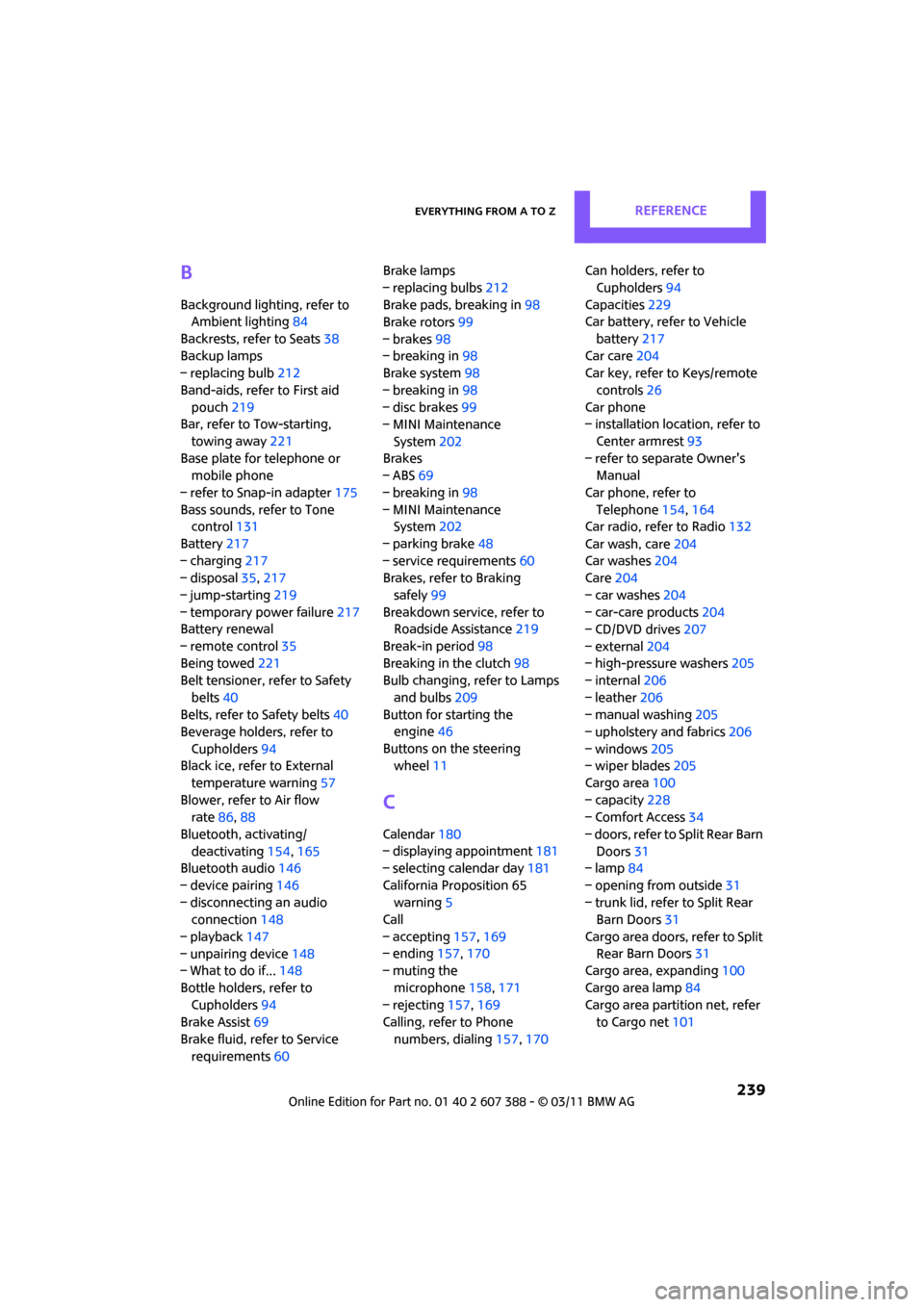
Everything from A to ZREFERENCE
239
B
Background lighting, refer to
Ambient lighting 84
Backrests, refer to Seats 38
Backup lamps
– replacing bulb 212
Band-aids, refer to First aid pouch 219
Bar, refer to Tow-starting,
towing away 221
Base plate for telephone or mobile phone
– refer to Snap-in adapter 175
Bass sounds, refer to Tone control 131
Battery 217
– charging 217
– disposal 35,217
– jump-starting 219
– temporary power failure 217
Battery renewal
– remote control 35
Being towed 221
Belt tensioner, refer to Safety
belts 40
Belts, refer to Safety belts 40
Beverage holders, refer to
Cupholders 94
Black ice, refer to External
temperature warning 57
Blower, refer to Air flow rate 86,88
Bluetooth, activating/ deactivating 154,165
Bluetooth audio 146
– device pairing 146
– disconnecting an audio connection 148
– playback 147
– unpairing device 148
– What to do if... 148
Bottle holders, refer to Cupholders 94
Brake Assist 69
Brake fluid, refer to Service requirements 60 Brake lamps
– replacing bulbs
212
Brake pads, breaking in 98
Brake rotors 99
– brakes 98
– breaking in 98
Brake system 98
– breaking in 98
– disc brakes 99
– MINI Maintenance
System 202
Brakes
– ABS 69
– b
reaking in 98
– MINI Maintenance System 202
– parking brake 48
– service requirements 60
Brakes, refer to Braking
safely 99
Breakdown service, refer to Roadside Assistance 219
Break-in period 98
Breaking in the clutch 98
Bulb changing, refer to Lamps
and bulbs 209
Button for starting the engine 46
Buttons on the steering wheel 11
C
Calendar 180
– displaying appointment 181
– selecting calendar day 181
California Proposition 65 warning 5
Call
– accepting 157,169
– ending 157,170
– muting the
microphone 158,171
– rejecting 157,169
Calling, refer to Phone
numbers, dialing 157,170 Can holders, refer to
Cupholders 94
Capacities 229
Car battery, refer to Vehicle
battery 217
Car care 204
Car key, refer to Keys/remote
controls 26
Car phone
– installation location, refer to
Center armrest 93
– refer to separate Owner's Manual
Car phone, refer to Telephone 154,164
Car radio, refer to Radio 132
Car wash, care 204
Car washes 204
Care 204
– car washes 204
– car-care products 204
– CD/DVD drives 207
– external 204
– high-pressure washers 205
– internal 206
– leather 206
– manual washing 205
– upholstery and fabrics 206
– windows 205
– wiper blades 205
Cargo area 100
– capacity 228
– Comfort Access 34
– doors, refer to Split Rear Barn Doors 31
– lamp 84
– opening from outside 31
– trunk lid, refer to Split Rear Barn Doors 31
Cargo area doors, refer to Split Re
ar Barn Doors 31
Cargo area, expanding 100
Cargo area lamp 84
Cargo area partition net, refer to Cargo net 101
Page 247 of 256
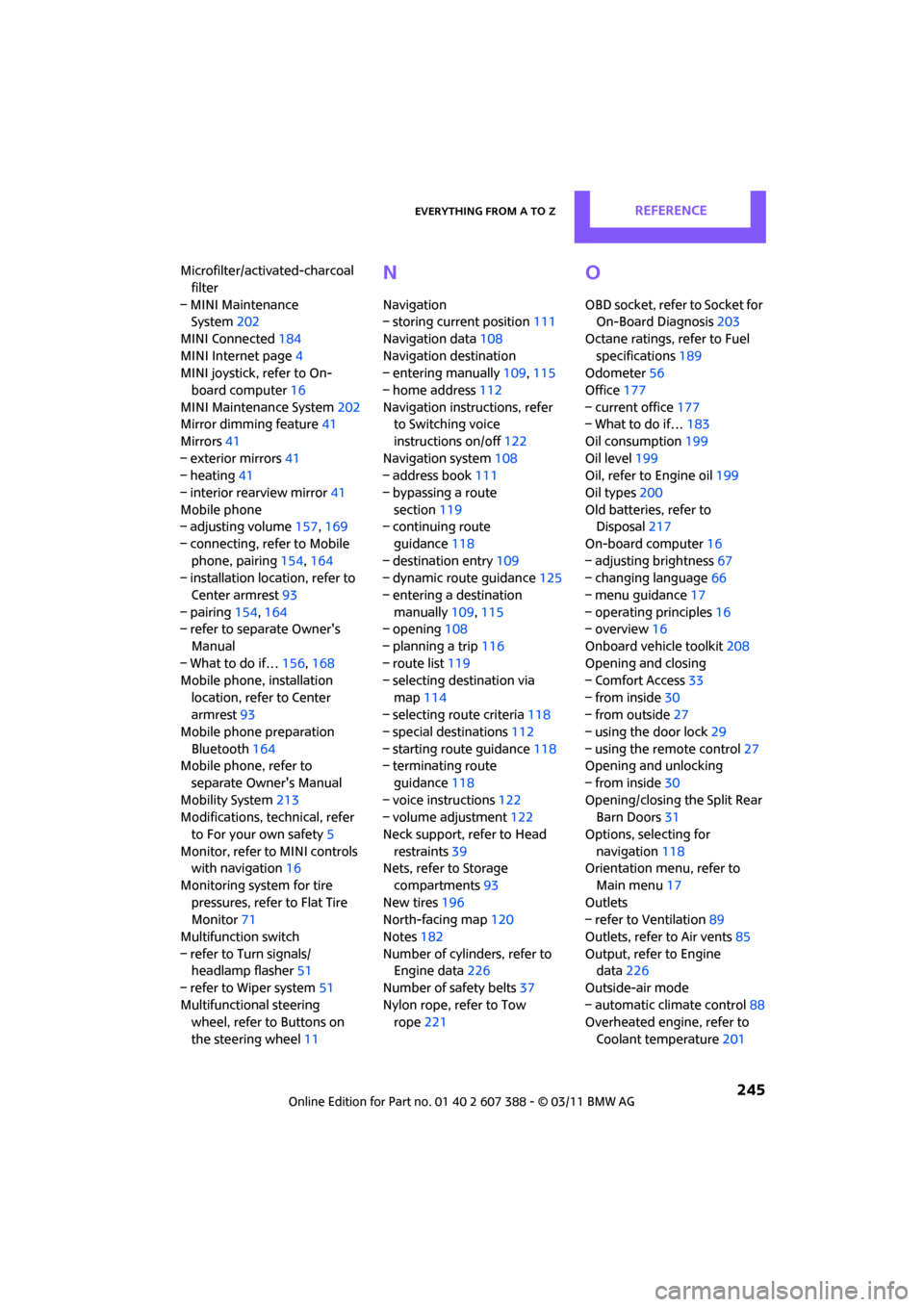
Everything from A to ZREFERENCE
245
Microfilter/activated-charcoal filter
– MINI Maintenance System 202
MINI Connected 184
MINI Internet page 4
MINI joystick, refer to On-
board computer 16
MINI Maintenance System 202
Mirror dimming feature 41
Mirrors 41
– exterior mirrors 41
– heating 41
– interior rearview mirror 41
Mobile phone
– adjusting volume 157,169
– connecting, refer to Mobile phone, pairing 154,164
– installation location, refer to
Center armrest 93
– pairing 154,164
– refer to separate Owner's
Manual
– What to do if… 156,168
Mobile phone, installation
location, refer to Center
armrest 93
Mobile phone preparation
Bluetooth 164
Mobile phone, refer to
separate Owner's Manual
Mobility System 213
Modifications, te chnical, refer
to For your own safety 5
Monitor, refer to MINI controls with navigation 16
Monitoring system for tire pressures, refer to Flat Tire
Monitor 71
Multifunction switch
– refer to Turn signals/ headlamp flasher 51
– refer to Wiper system 51
Multifunctional steering wheel, refer to Buttons on
the steering wheel 11N
Navigation
– storing current position 111
Navigation data 108
Navigation destination
– entering manually 109,115
– home address 112
Navigation instructions, refer to Switching voice
instructions on/off 122
Navigation system 108
– address book 111
– bypassing a route section 119
– continuing route
guidance 118
– destination entry 109
– dynamic route guidance 125
– entering a destination manually 109,115
– opening 108
– planning a trip 116
– route list 119
– selecting destination via
map 114
– selecting route criteria 118
– special destinations 112
– starting route guidance 118
– terminating route
guidance 118
– voice instructions 122
– volume adjustment 122
Neck support, refer to Head restraints 39
Nets, refer to Storage
compartments 93
New tires 196
North-facing map 120
Notes 182
Number of cylinders, refer to Engine data 226
Number of safety belts 37
Nylon rope, refer to Tow rope 221
O
OBD socket, refer to Socket for
On-Board Diagnosis 203
Octane ratings, refer to Fuel specifications 189
Odometer 56
Office 177
– current office 177
– What to do if… 183
Oil consumption 199
Oil level 199
Oil, refer to Engine oil 199
Oil types 200
Old batteries, refer to Disposal 217
On-board computer 16
– adjusting brightness 67
– changing language 66
– menu guidance 17
– operating principles 16
– overview 16
Onboard vehicle toolkit 208
Opening and closing
– Comfort Access 33
– from inside 30
– from outside 27
– using the door lock 29
– using the remote control 27
Opening and unlocking
– from inside 30
Opening/closing the Split Rear Barn Doors 31
Options, selecting for navigation 118
Orientation menu, refer to
Main menu 17
Outlets
– refer to Ventilation 89
Outlets, refer to Air vents 85
Output, refer to Engine data 226
Outside-air mode
– automatic climate control 88
Overheated engine, refer to
Coolant temperature 201
Page 250 of 256
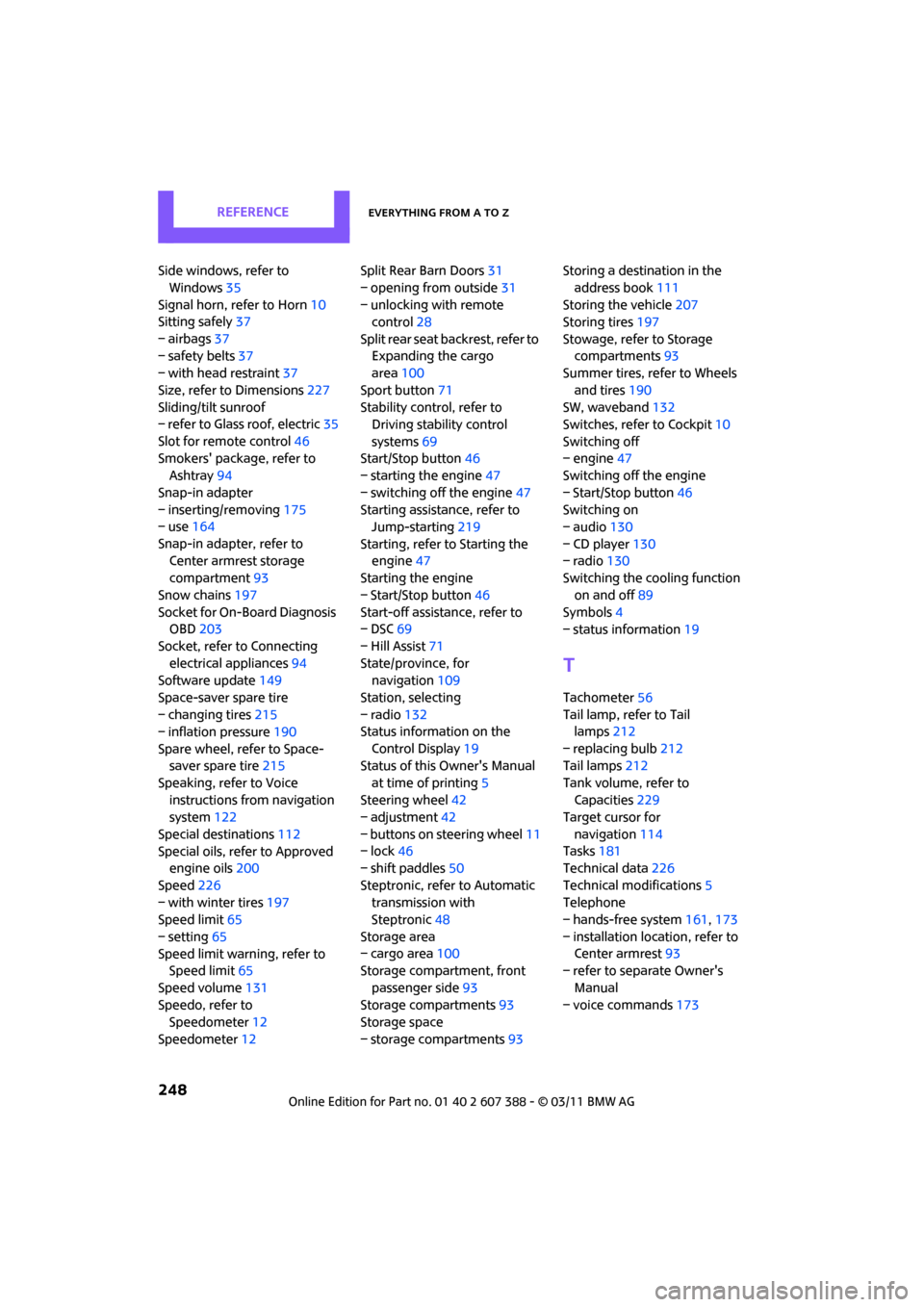
REFERENCEEverything from A to Z
248
Side windows, refer to Windows 35
Signal horn, refer to Horn 10
Sitting safely 37
– airbags 37
– safety belts 37
– with head restraint 37
Size, refer to Dimensions 227
Sliding/tilt sunroof
– refer to Glass roof, electric 35
Slot for remote control 46
Smokers' package, refer to Ashtray 94
Snap-in adapter
– inserting/removing 175
– use 164
Snap-in adapter, refer to Center armrest storage
compartment 93
Snow chains 197
Socket for On-Board Diagnosis OBD 203
Socket, refer to Connecting electrical appliances 94
Software update 149
Space-saver spare tire
– changing tires 215
– inflation pressure 190
Spare wheel, refer to Space- saver spare tire 215
Speaking, refer to Voice instructions from navigation
system 122
Special destinations 112
Special oils, refer to Approved engine oils 200
Speed 226
– with winter tires 197
Speed limit 65
– setting 65
Speed limit warning, refer to Speed limit 65
Speed volume 131
Speedo, refer to Speedometer 12
Speedometer 12 Split Rear Barn Doors
31
– opening from outside 31
– unlocking with remote control 28
Split rear seat backrest, refer to Expanding the cargo
area 100
Sport button 71
Stability contro l, refer to
Driving stability control
systems 69
Start/Stop button 46
– starting the engine 47
– switching off the engine 47
Starting assistance, refer to Jump-starting 219
Starting, refer to Starting the engine 47
Sta
rting the engine
– Start/Stop button 46
Start-off assistance, refer to
– DSC 69
– Hill Assist 71
State/province, for navigation 109
Station, selecting
– radio 132
Status information on the
Control Display 19
Status of this Owner's Manual
at time of printing 5
Steering wheel 42
– adjustment 42
– buttons on steering wheel 11
– lock 46
– shift paddles 50
Steptronic, refer to Automatic transmission with
Steptronic 48
Storage area
– cargo area 100
Storage compartment, front
passenger side 93
Storage compartments 93
Storage space
– storage compartments 93Storing a destination in the
address book 111
Storing the vehicle 207
Storing tires 197
Stowage, refer to Storage compartments 93
Summer tires, refer to Wheels
and tires 190
SW, waveband 132
Switches, refer to Cockpit 10
Switching off
– engine 47
Switching off the engine
– Start/Stop button 46
Switching on
– audio 130
– CD player 130
– radio 130
Switching the cooling function
on and off 89
Symbols 4
– status information 19
T
Tachometer56
Tail lamp, refer to Tail lamps 212
– replacing bulb 212
Tail lamps 212
Tank volume, refer to Capacities 229
Target cursor for
navigation 114
Tasks 181
Technical data 226
Technical modifications 5
Telephone
– hands-free system 161,173
– installation lo cation, refer to
Center armrest 93
– refer to sepa rate Owner's
Manual
– voice commands 173
Page 251 of 256
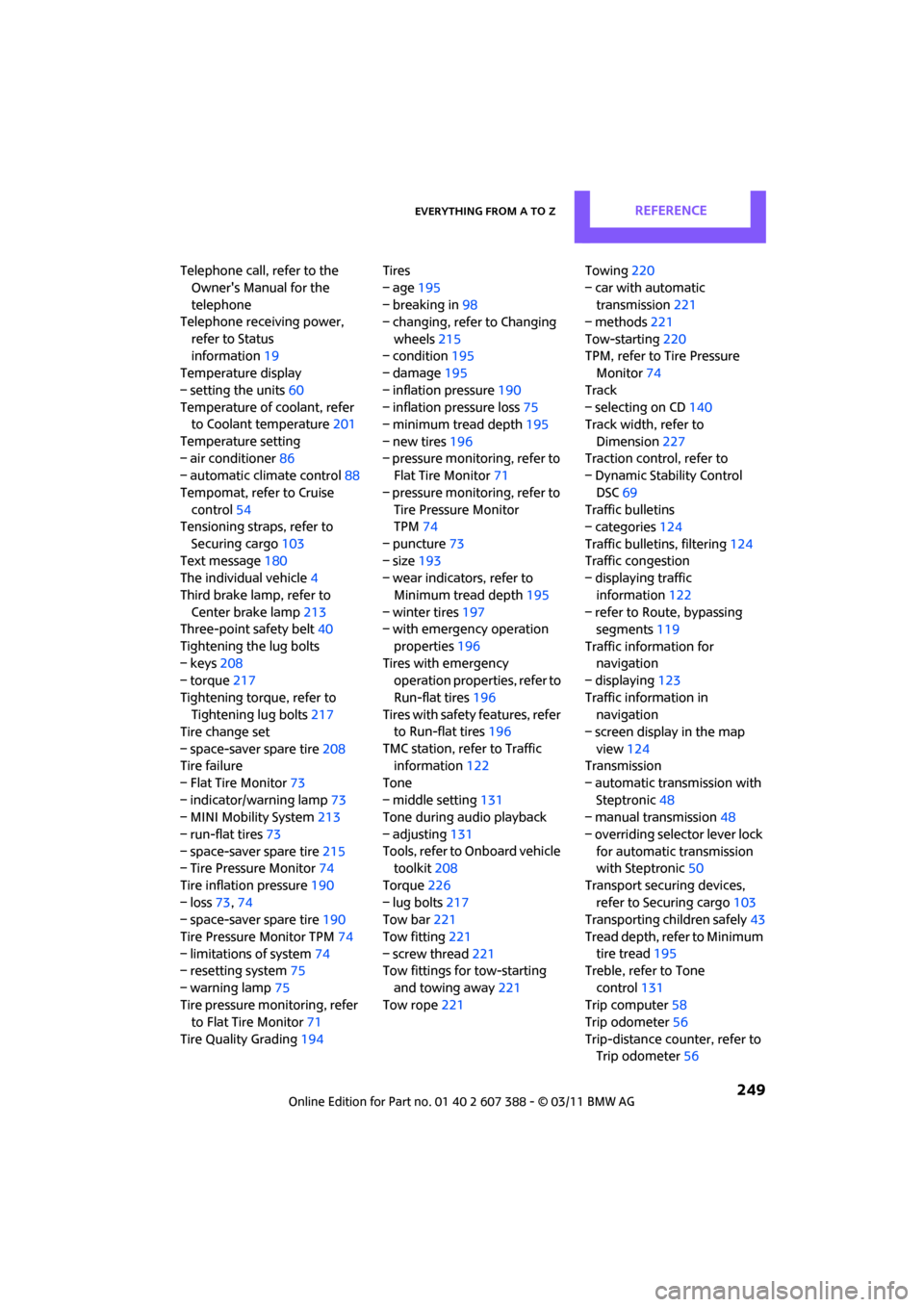
Everything from A to ZREFERENCE
249
Telephone call, refer to the Owner's Manual for the
telephone
Telephone receiving power,
refer to Status
information 19
Temperature display
– setting the units 60
Temperature of coolant, refer to Coolant temperature 201
Temperature setting
– air conditioner 86
– automatic climate control 88
Tempomat, refer to Cruise control 54
Tensioning straps, refer to
Securing cargo 103
Text message 180
The individual vehicle 4
Third brake lamp, refer to Center brake lamp 213
Three-point safety belt 40
Tightening the lug bolts
– keys 208
– torque 217
Tightening torque, refer to Tightening lug bolts 217
Tire change set
– space-saver spare tire 208
Tire failure
– Flat Tire Monitor 73
– indicator/warning lamp 73
– MINI Mobility System 213
– run-flat tires 73
– space-saver spare tire 215
– Tire Pressure Monitor 74
Tire inflation pressure 190
– loss 73,74
– space-saver spare tire 190
Tire Pressure Monitor TPM 74
– limitations of system 74
– resetting system 75
– warning lamp 75
Tire pressure monitoring, refer to Flat Tire Monitor 71
Tire Quality Grading 194Tires
– age
195
– breaking in 98
– changing, refe r to Changing
wheels 215
– condition 195
– damage 195
– inflation pressure 190
– inflation pressure loss 75
– minimum tread depth 195
– new tires 196
– pressure monitoring, refer to Flat Tire Monitor 71
–
pressure monitoring, refer to Tire Pressure Monitor
TPM 74
– puncture 73
– size 193
– wear indicators, refer to
Minimum tread depth 195
– winter tires 197
– with emergency operation
properties 196
Tires with emergency operation properties, refer to
Run-flat tires 196
Tires with safety features, refer
to Run-flat tires 196
TMC station, refer to Traffic information 122
Tone
– middle setting 131
Tone during audio playback
– adjusting 131
Tools, refer to Onboard vehicle toolkit 208
Torque 226
– lug bolts 217
Tow bar 221
Tow fitting 221
– screw thread 221
Tow fittings for tow-starting
and towing away 221
Tow rope 221 Towing
220
– car with automatic transmission 221
– methods 221
Tow-starting 220
TPM, refer to Tire Pressure Monitor 74
Track
– selecting on CD 140
Track width, refer to
Dimension 227
Traction control, refer to
– Dynamic Stability Control
DSC 69
Traffic bulletins
– categories 124
Traffic bulletins, filtering 124
Traffic congestion
– displaying traffic
information 122
– refer to Route, bypassing segments 119
Traffic information for navigation
– displaying 123
Traffic information in navigation
– screen display in the map
view 124
Transmission
– automatic transmission with Steptronic 48
– manual transmission 48
– overriding selector lever lock for automatic transmission
with Steptronic 50
Transport securing devices, refer to Securing cargo 103
Tr
ansporting children safely 43
Tread depth, refer to Minimum tire tread 195
Treble, refer to Tone
control 131
Trip computer 58
Trip odometer 56
Trip-distance counter, refer to Trip odometer 56